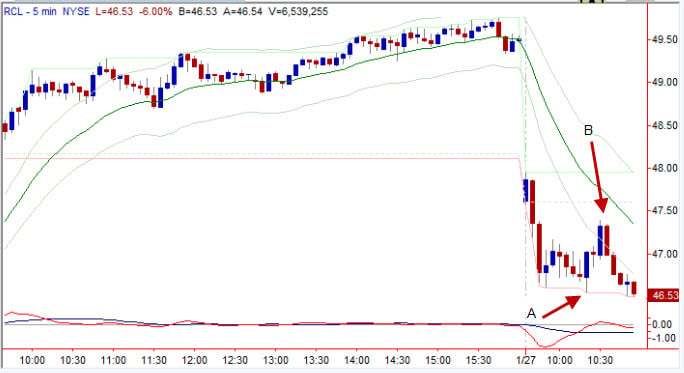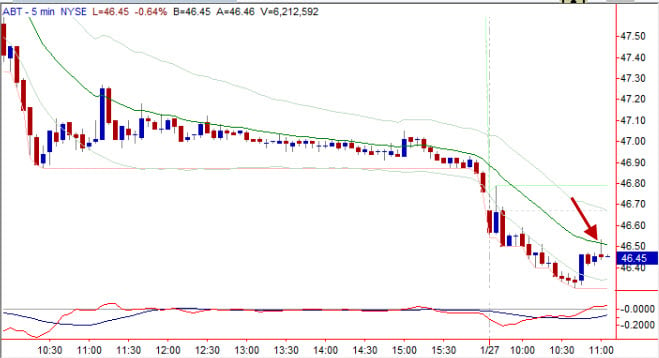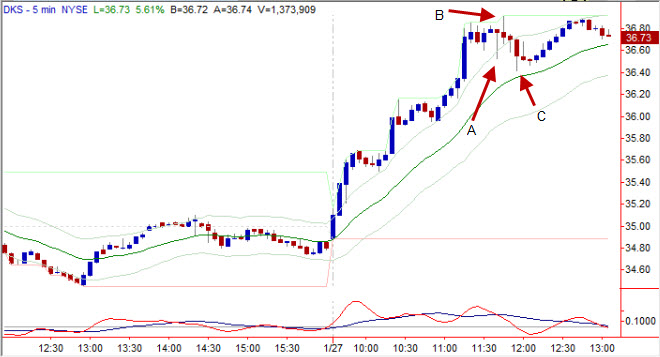I’m not a great chess player. I’ve studied the game quite a bit, but found I don’t really have the temperament or mindset to be a really good. The reason, which actually helps me as a trader I think, is that rather than thoroughly investigate the possibilities in a position, I would rather make a move and deal with the conse-quences. In trading this carries over into a “no fear” attitude about any trade and then an immediate focus on managing the risk. So I guess it’s not a bad thing. Having said that, I do play an interesting game of chess, and my strategy is usually based on giving my opponent the opportunity to make mistakes. The market does the same thing to us every day.
This post is the result of some thinking I’ve been doing over the past six weeks, culminating in a conversation I had with Bella after the close yesterday. I guess I should say that I agree with what he is saying in these posts, that we are seeing stocks hold levels less cleanly, and we are seeing more times we get “wicked out” of good trades. I’m not so sure that it is a result of HFTs, and I wonder if it is more due to lower volume and more uncertainty as the market takes a pause after a big run up. If there are less natural buyers (or sellers), then market makers will keep a little less size in the book and there is less liquidity to absorb even medium-sized orders.
Also, consider that one respected theory of market action says that markets basically exist to create trading volume. Markets “know” where stops are, and markets seek those areas in order to create the volume that will come from those price level. One of my most successful swing trading patterns was based on just this concept—the market runs stops, but does not have any real buying/selling pressure to sustain the move. Many of the best technical patterns are fueled by trapped traders scrambling to get on the right side of the market, which is one reason why failures have always presented good opportunities.
We’re splitting hairs here, and whether these moves are the result of HFTs or natural market action, the fact is that we are seeing more good patterns break down with fake-out moves. My challenge to you is to consider how you will trade these moves. Ask yourself constantly, “Who just got screwed?” “Who just made a mistake?” And realize that those people will likely provide fuel for the fire if the move reverses. Also, if the answer to “who just made a mistake” is “me”, fix it before real damage is done. This is a market that is rewarding micro-managing of positions with relative tight risk points.
Let’s look at a few examples from today’s trading. In each of these, arrows outline places that someone got screwed or someone made a mistake. I was fortunate to be on the right side of most of these moves, but there are good lessons on both side.
RCL reported earnings today and was down quite a bit early in the day. I shorted just before the arrow marked A. All that happened here was the market gave people the opportunity to hit the lows, before rebidding and quickly sweeping the stock higher. I was on the wrong side, and not quick enough to adjust my position. An unnecessary 50 cent rip. However, the bigger pattern here is a consolidation at the lows, whether you label it range, flag, line, or whatever. Do you think the bulls were excited after the big blue candel at the arrow marked B? Sure they were, especially after the failure at the low of the day. Do you think they were disappointed when the next big red candle showed that they had failed, and the market was back in the range? Were there trapped bulls? Uh huh. I reshorted just below 47.00 when I realized that shorts were probably just wicked out by that drive up to the half. (What labels you attach to the candles, tweezer tops etc, are unimportant. What is important is that you understand what the pattern says about the battle going on between buyers and sellers.)
Sometimes this is subtle. This is not a pullback I would normally have sold, but seeing people “wicked out” of shorts in ABT, gave me a good spot for the short entry.
DKS turned out to be a little more difficult, with some multiple failures on both sides. I took a few losses early on in this stock, but eventually was lucky to break even in it. Notice that A and C both wicked out buyers past any reasonable stop levels, while B was a failure test above the high of the day. In all of these cases, the market simply presented people with an opportunity to make a mistake. I bought heavily after the momentum turned after the C wick, but this was certainly not a clean trade in any sense of the word.
What you do with this information is up to you, but you should at least look at your recent trades and see where you were on the wrong side of moves like this. Though it is extremely uncomfortable, if you realize you just got “wicked out”, it probably makes sense to pay quickly to get back into the stock. Of course, there’s risk here, because if it was real you just compounded your loss, but, on balance, the numbers seem to working in favor of those who aggressively re-enter. As you watch stocks over the next few weeks, ask yourself constantly, “Who just got screwed? Who just made a mistake?”—there is money to be made in punishing those mistakes!





11 Comments on “Why Am I Getting Stopped Out More? (Part III)”
Love your blogs. Your writing is detailed and effective and gets your point across clearly.
Adam, my theory of this type of market is that there is no need to buy. The only reason a stock should hold its levels or trade higher is if there is a necessity to buy. From the institutional level, what reason would they have to aggressively buy a stock? When they do, they become very aggressive at it. Take a look at AIG on 12/9/2010. It was real clean because buyers needed to buy and very aggressively.
These days, most buying is performed by passive buy programs. They buy and drop, buy and drop. If they get too much action then they just drop. Why should a certain price level hold? Only if they have a reason to hold that price which means they really need to fill a big order.
These days there is very little need to accumulate stock aggressively on most days and if you’re trying out outsmart passive buy programs, you are going to get very frustrated.
My solution to this is to just stay the hell away on most days and hit these suckers hard when they come around. You can make a whole month or quarter on stuff like AIG. Love to hear your thoughts.
Ouch, I was one trader wicked out on ABT. Should have been a very profitable trade, rip. Your explanation is going in my journal tonight.
I was starting to feel that my end as a trader is near, because for the first time I begin blaming others for my rips, and that is the HFTs. These programs coupled with a market at some psychological resistance levels can crush a trader confidence. Changing the approach to ‘who just got screwed?’ and being aggressive with the re-entrance – and yes, it is a very valid strategy for the market these days – is too much for me. I will take a brake from the effective trading and work on the sidelines. The battle in the market right now seems like a Waterloo moment for me.
Another great post, thanks Adam. I got screwed shorting a couple of stocks at resistance 2 days ago underestimating the strength of the market. I was about to turn off for the day when Mikes words rung in my ears to tough it out with the potential to make gains back. Realizing the strength that was doing me in I reversed and went long into 1 of the stocks, and flew on to my target. Finally the lessons are starting to sink in – thanks to you all !!!
good post, definitely has been going on a while, good example is RIG around $80 for the past 2 days…program working the real spread in that
thank you
check for a new blog from me this weekend
From a swing perspective, it was difficult to justify shorts 2 days ago… stocks may have been at “resistance”, but the overall tone of the market was so strong. I was looking for a spot to go short, but today’s close was really the first reasonable spot imo. Be careful of fading a strong market using the justification of stocks at “resistance”… (and remember, I don’t let the traders I train say (or, hopefully, even think) “resistance”. it is always “POTENTIAL resistance”. small but important difference.)
I disagree. You just referred to something that happened a month and a half ago. If you are a professional, you have to trade more often than that. Every day there are stocks that are in play with unusual order flow… and these are the stocks we focus on. it doesn’t have to be an extreme example like AIG.
I also am pretty familiar with execution algos, being a heavy user of them in a previous job. They are not as ominious as you think… the only thing they have done is to remove the old school giant order in the book and to increase the noise level a bit. Frustrating, but we certainly don’t try to outsmart these algos.
I think you are correct in that some days are better than others and justify more risk… the sooner in the day you can identify those days you should be chilling out, the better off your bottom line is. Where we differ is that I think it is possible for skilled, profiessional traders to make money most days of the week, and perhaps to have 2-5 days a month where it really justifies laying into it and assuming real risk. Just my opinion.
Seems you have done good resource on this.